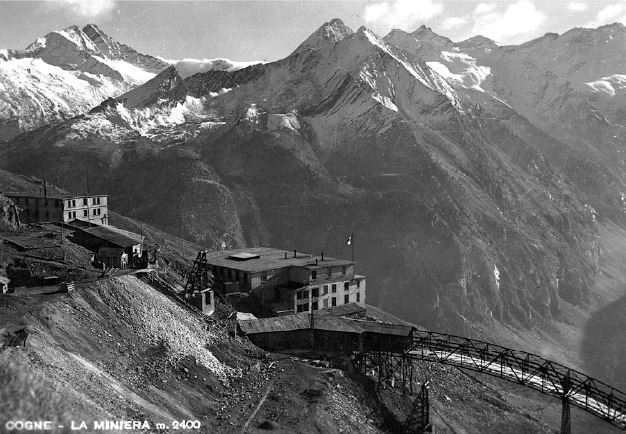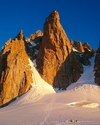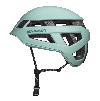The Cogne mines, between the past and the future - part 1

 1 / 4
1 / 4 Fondation grand Paradis e Comune di Cogne
Fondation grand Paradis e Comune di Cogne
Let’s imagine a small mountain village located at 8000 feet above sea level, on the slopes of Monte Creya in Italy's Aosta Valley. A stunning view abounds: Punta Sengia, the Gran Paradiso massif, Grivola and Mont Blanc. Looking down, the meadows around Saint Orso fields and the village of Cogne. There is a cinema, a barber shop, a church and also a library. There's also the highest bowls playground in Europe. 200 people up live here and a cable car allows them to go down to the village, only to those who have a family there, and only once a week.
It’s easy to understand that Colonna – this is the name of a village – isn't a normal village. In fact, it's the highest outpost of the Cogne mines, or maybe we could say of the highest outpost of Cogne itself, seeing that the bond between these two has always been strong, between the alpine village and its magnetite mine. Even after 1979 when the industry officially closed down.
"On my first day at work I was a bit scared, I had never worked in a mine before and is was extremely noisy. I was afraid of everything, I could hear the minerals going down to the wells even if I did not really realise what that meant. I just could hear the noise, crawling inside the mountain" (1) These are Bruno Mei’s words, a miner who worked there during the mine's last ten years.
The first shift starts at 6am, a hundred men descend into the guts of the mountain and start working and digging at different levels. The temperature is 6/7 °C degrees all year long. It’s a hard life but it’s a strain that you end up loving.
"In my life I have never thought of leaving the mine and not even doing anything different. To me, being a miner is the ultimate job" (2) says Benvenuto Mei.
A red thread
The history of Cogne is tightly bonded with the history of its mines: just think that the first traces of this kind of activity date back to 1433. The efforts of Doctor Grappein – mayor of the village at the beginning of the XIX century - represent a significant milestone in the mine's history as he experimented a form of communitarian management to improve the workers' living conditions. He also built the road connecting Cogne to Vieyes.
The experience ended abruptly and we have to wait until the beginning of XX century in order to see new activity around the mines when Belgian entrepreneur Alfred Theys and Count Van der Straten Ponthoz founded the Società Anonima Miniere di Cogne. The entire vein was estimated at being somewhere in the region of more than 5 million tons of mineral.
Small industries grow
The Colonna compound was established in those years: in 1917 the company was merged with "Gio. Ansaldo" that built the Aosta steel plant and, in 1922, the railway connecting Cogne and Acque Fredde. 12 km in total, and with a tunnel that is 8 km long, this was the longest narrow-gauge railway in Europe at the time.
How does the production cycle work? Minerals are extracted at 8000 feet above sea level, carried by cable car to Moline at about 5000 feet and then broken up before being carried again by train to Acque Fredde. A second cable car finally covers the last part of the journey to Aosta.
Franz Elter and the culmination of an era
Società Anonima Nazionale Cogne was created in 1927 as a government-controlled company, under the management of Franz Elter. Elter, who also played a primary role during the liberation of the valley after the Second World War, introduced new methods of extraction and quickly became one of the most important mining expert in Italy.
As of the Thirties, the Cogne mine experienced a strong growth, thanks also to the increased demand for iron because of the War. The total number of employees rose to 10,000 and they came from all aver Italy: from Veneto to Sardinia, from Lombardy to Calabria. 350,000 tons of minerals were extracted in 1940.
"I have always considered the mine as a big resource for our community. Our dream, ever since we were children, was to get a job in these mines" (3) says Osvaldo Ruffier, a miner and subsequently mayor of Cogne.
"I remember when I was a child" says Bruna Bertino, employee in the financial department "when my father descended from Colonna, he brought home his linen to be washed: it had such a strange smell (…) It’s like I can feel it again in my nostrils, that smell of those overalls, of those clothes coming from the guts of the mountain" (4)
The crisis
Although the first signs of the upcoming crisis became evident at the start of the Forties, the Cogne mine continued working until the end of the Seventies. In this time period the Colonna compound was abandoned and the activity was moved to Costa del Pino. The Miners Village in Moline was inaugurated; with its 6 buildings it provided services and and could host up to 400 people.
As time went by, the Cogne mine lost competitiveness, basically due to local and international competitors. It finally closed down in 1979 while the mining concession
remains active until 31 October. As of this date, even ordinary maintenance works will cease.
It is once again Benvenuto Mei’s words that accompany us and describe the last day of activity of the mines.
"The day before the mine closed I was so sad. We all wanted our jobs back in the mines, no matter how hard it was (…). This job taught us solidarity and allowed us and our families many things we could not afford without."
What is left today of all this? What will it happen now that even the ordinary maintenance works will be stopped? What does a tourist, arriving at Cogne, understand about the history that shaped this village? Are we still able to listen to the voice of our every-day ruins, to cut ourselves off from a present that seems to absorb everything and that is outsourcing our memory to search engines? The history of the Cogne mines is not finished yet…
by Simonetta Radice
1) Giò Gozzi, "Cogne, Miniere e Minatori", Milano, FBE Edizioni, 2009, pag 90 e seguenti
2) Ibidem, pag.50
3) Ibidem, pag 72
4) Ibidem, pag 110
- READ THE PART 2 -
The Cogne mines between the past and the future



 Copia link
Copia link
























